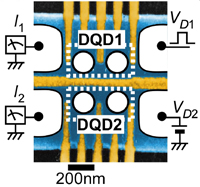Quantum information processing is attractive for performing efficient algorithms that can’t be run on ordinary computers, and demonstrating new phenomena with intriguing non-classical characteristics. This technology relies on coherent manipulation of quantum bits, or qubits, which have been demonstrated in various materials.
Two-qubit manipulations are key ingredients to realize quantum information processing. However, only one type of two-qubit manipulations has been demonstrated in each device. For useful information processing it is desirable to operate various two-qubit manipulations selectively in one device.
Now, Toshimasa Fujisawa and colleagues at NTT Basic Research Laboratories and Tokyo Institute of Technology have demonstrated that some important two-qubit manipulations (called for example CNOT and SWAP) can be performed in an integrated device made with semiconductor quantum dots.
In their device, two double quantum-dots, each working as a charge qubit, are driven by a high-speed voltage pulse to induce coherent electronic motion based on quantum mechanics. To make this work, the researchers carried out their experiment at an extremely low temperature of about 0.1 K.
Under some conditions, the first qubit shows coherent motion that depends on the second qubit, corresponding to a CNOT manipulation. Under other conditions, the two qubits exhibit correlated motion, which can be used for SWAP and other two-qubit manipulation. In this way, the system acts as a multifunction manipulation.
This successful experiment brings semiconductor-based quantum information processing one step closer to reality
- Authors: Gou Shinkai, Toshiaki Hayashi, Takeshi Ota, and Toshimasa Fujisawa
- Title of original paper: Correlated coherent oscillations in coupled semiconductor charge qubits
- Journal, volume, pages and year: Phys. Rev. Lett. 103, 056802 (2009).
- Digital Object Identifier (DOI): 10.1103/PhysRevLett.103.056802
- Affiliations: NTT Basic Research Laboratories, NTT Corporation and Department of Physics, Tokyo Institute of Technology.

A coupled double-quantum-dot device.
. Any information published on this site will be valid in relation to Science Tokyo.



